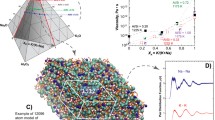Abstract
Diffusion of water was experimentally investigated for melts of albitic (Ab) and quartz-orthoclasic (Qz29Or71, in wt %) compositions with water contents in the range of 0 to 8.5 wt % at temperatures of 1100 to 1200 °C and at pressures of 1.0 and 5.0 kbar. Apparent chemical diffusion coefficients of water (D water) were determined from concentration-distance profiles measured by FTIR microspectroscopy. Under the same P-T condition and water content the diffusivity of water in albitic, quartz-orthoclasic and haplogranitic (Qz28Ab38 Or34, Nowak and Behrens, this issue) melts is identical within experimental error. Comparison to data published in literature indicates that anhydrous composition only has little influence on the mobility of water in polymerized melts but that the degree of polymerization has a large effect. For instance, Dwater is almost identical for haplogranitic and rhyolitic melts with 0.5–3.5 wt % water at 850 °C but it is two orders of magnitude higher in basaltic than in haplogranitic melts with 0.2–0.5 wt % water at 1300 °C. Based on the new water diffusivity data, recently published in situ near-infrared spectroscopic data (Nowak 1995; Nowak and Behrens 1995), and viscosity data (Schulze et al. 1996) for hydrous haplogranitic melts current models for water diffusion in silicate melts are critically reviewed. The NIR spectroscopy has indicated isolated OH groups, pairs of OH groups and H2O molecules as hydrous species in polymerized silicate melts. A significant contribution of isolated OH groups to the transport of water is excluded for water contents above 10 ppm by comparison of viscosity and water diffusion data and by inspection of concentration profiles from trace water diffusion. Spectroscopic measurements have indicated that the interconversion of H2O molecules and OH pairs is relatively fast in silicate glasses and melts even at low temperature and it is inferred that this reaction is an active step for migration of water. However, direct jumps of H2O molecules from one cavity within the silicate network to another one can not be excluded. Thus, we favour a model in which water migrates by the interconversion reaction and, possibly, small sequences of direct jumps of H2O molecules. In this model, immobilization of water results from dissociation of the OH pairs. Assuming that the frequency of the interconversion reaction is faster than that of diffusive jumps, OH pairs and water molecules can be treated as a single diffusing species having an effective diffusion coefficient The shape of curves of Dwater versus water content implies that increases with water content. The change from linear to exponential dependence of Dwater between 2 and 3 wt % water is attributed to the influence of the dissociation reaction at low water content and to the modification of the melt structure by incorporation of OH groups.
Similar content being viewed by others
Author information
Authors and Affiliations
Additional information
Received: 26 March 1996 / Accepted: 23 August 1996
Rights and permissions
About this article
Cite this article
Behrens, H., Nowak, M. The mechanisms of water diffusion in polymerized silicate melts. Contrib Mineral Petrol 126, 377–385 (1997). https://doi.org/10.1007/s004100050257
Published:
Issue Date:
DOI: https://doi.org/10.1007/s004100050257



